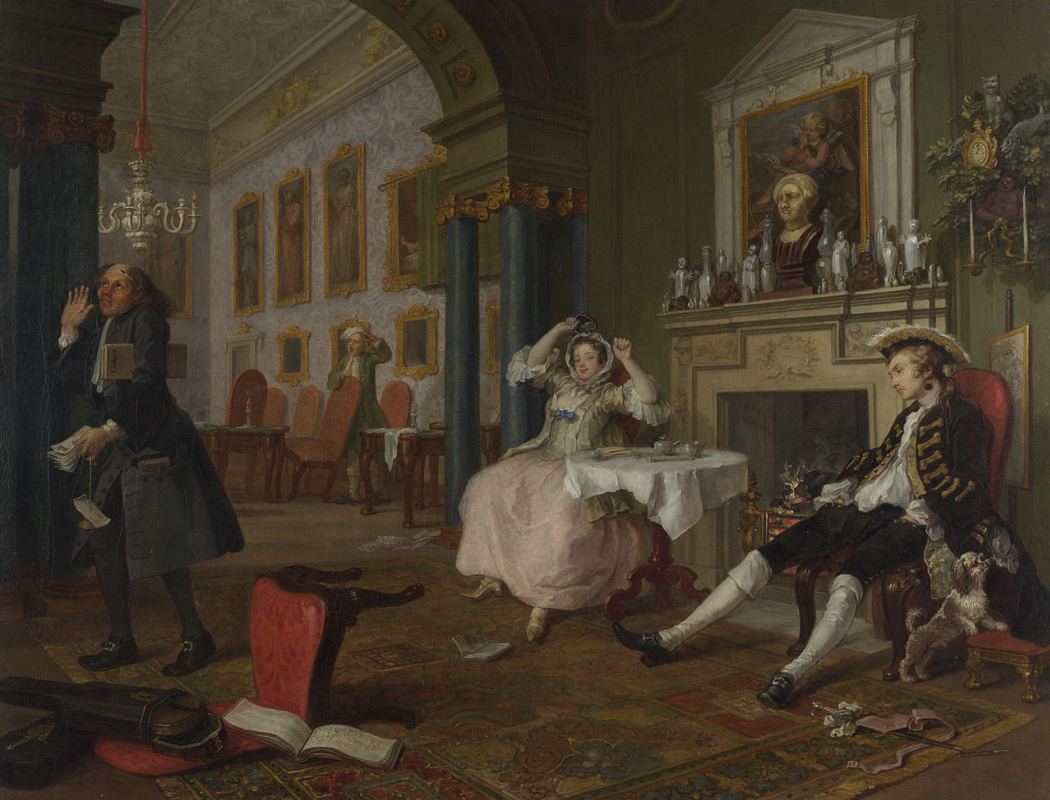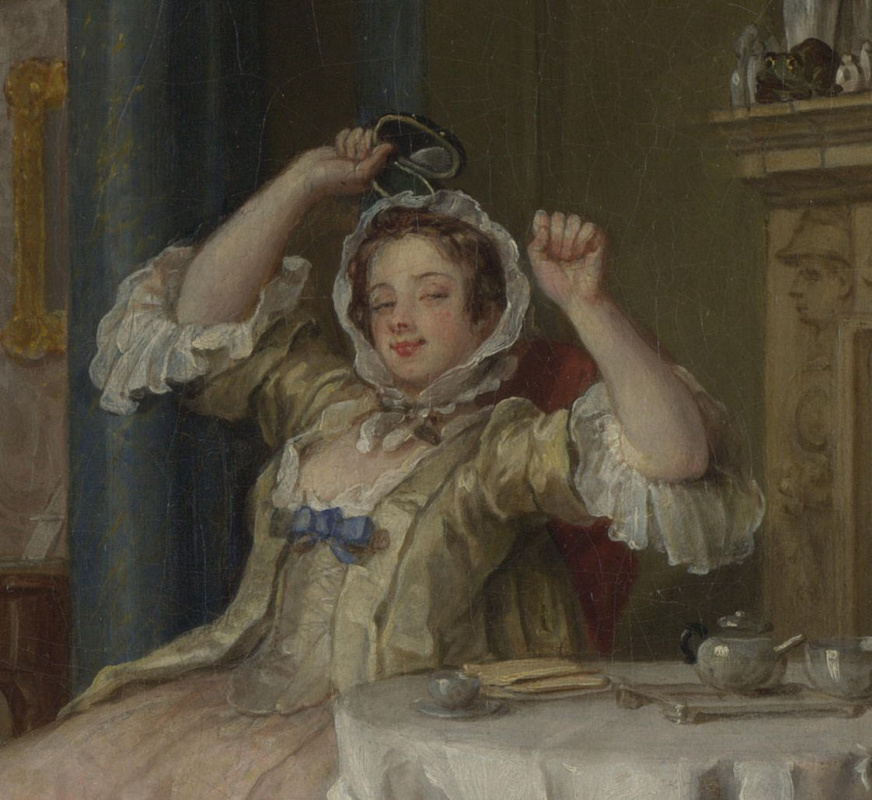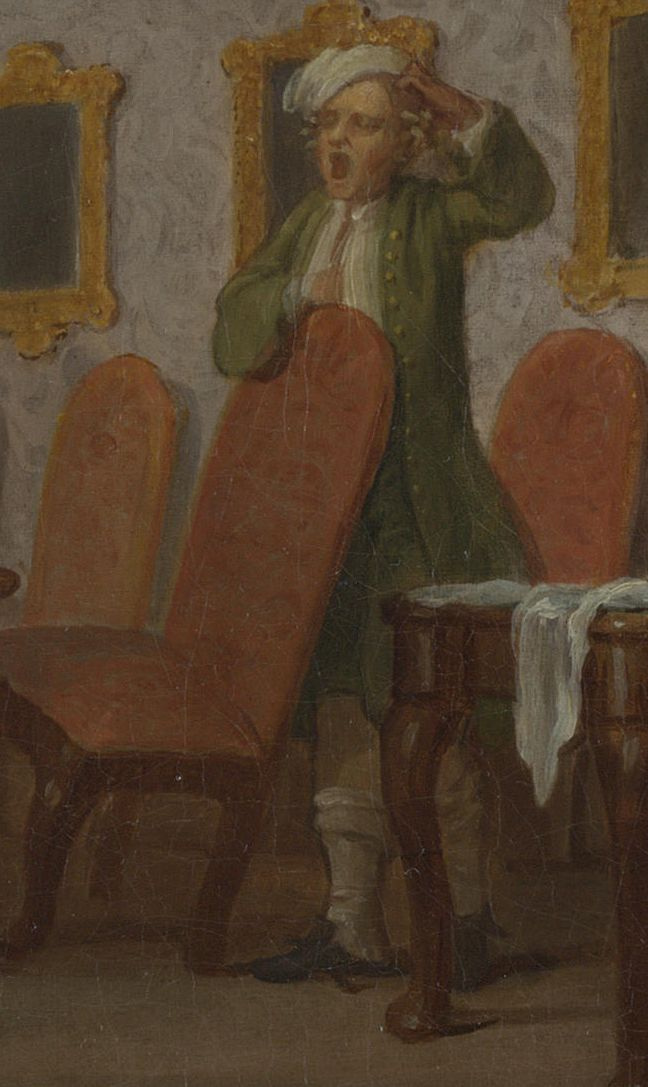log in
Enter site
Login to use Arthive functionality to the maximum
A fashionable marriage. Part 2. After the wedding
William Hogarth • Painting, 1743, 69.9×90.8 cm
Description of the artwork «A fashionable marriage. Part 2. After the wedding»
A series of six paintings "Fashionable marriage" considered the most significant and artistically perfect of several cycles of paintings created by William Hogarth ("Career prostitutes", Rake's progress, "The parliamentary elections" etc.) "Fashionable marriage" was created in the years 1743-1745, immediately after the return of the artist from Paris, and combines rich experience of Hogarth British chronicler with some of the newest French influences – first and foremost, of Rococo art.
The unequal marriage or a marriage of convenience since the emergence of genre painting has always been one of the most popular subjects. He did not, and Hogarth. In his case we are talking about the social misalliance: ruined the count's son, to improve their financial position, to marry a rich merchant's daughter. Phenomenon for contemporary Hogarth's England is more than a common and predictable development: the husband will spend the wife's money, wallowing in carousing and debauchery, and the wife will languish in pointless idleness, animated perhaps that love affair.
Came from France Rococo is not only a style of art. It is primarily a particular way of life – rich, elegant and idle. It's fashion. And this is why "Marriage" Hogarth – fashionable. The characters do not feel discomfort from the fact that they marry not for love, because each has its own benefits, and their marriage in the eyes of the light looks good and quite presentable. However, it will end sad. The count after a series of sprees will be in the crazy house, and then will be stabbed by the boyfriend of his wife. Lover gets on the scaffold, and the Countess will kill myself. So the moralist Hogarth punishes his characters for immorality and spiritual laziness.
The second part of the series "Fashion marriage" is one of the best in the whole cycle. It was called "After the wedding" and takes us to the house of heroes, eve became husband and wife. The room is luxuriously furnished and decorated in the latest fashion, but plunged into a monstrous mess. The floor was littered with sheet music and musical instruments, books, maps, overturned chairs, this suggests that yesterday's triumph over a fair Orgy. Pretty the Countess lazily stretches and not shown any signs of tenderness to the spouse. Important caveat: she is dressed "in the home" - a cap and hood, and her husband, judging by the clothes, recently, from somewhere in back. Obviously, he spent his wedding night outside the house, and his indifferent and tired look shows that his portion of pleasures he has already received "on the side".
Expressive and minor characters in the back of the room straightens chairs widely yawning servant. But the clerk with a wad of bills in his hands removed, rolling her eyes. It's like he calls upon the heavenly power to witness: these people can not be any serious business talk!
Soft harmonies of colors in this painting cycle "Fashionable marriage" (olive, pink, silver and gold) are typical of Rococo painting and pass external, ostentatious wealth of this family Union. But the chaotic, scattered arrangement emphasizes its internal disorder, the same emptiness that inevitably, according to Hogarth, will end in tragedy.
Author: Anna Yesterday
The unequal marriage or a marriage of convenience since the emergence of genre painting has always been one of the most popular subjects. He did not, and Hogarth. In his case we are talking about the social misalliance: ruined the count's son, to improve their financial position, to marry a rich merchant's daughter. Phenomenon for contemporary Hogarth's England is more than a common and predictable development: the husband will spend the wife's money, wallowing in carousing and debauchery, and the wife will languish in pointless idleness, animated perhaps that love affair.
Came from France Rococo is not only a style of art. It is primarily a particular way of life – rich, elegant and idle. It's fashion. And this is why "Marriage" Hogarth – fashionable. The characters do not feel discomfort from the fact that they marry not for love, because each has its own benefits, and their marriage in the eyes of the light looks good and quite presentable. However, it will end sad. The count after a series of sprees will be in the crazy house, and then will be stabbed by the boyfriend of his wife. Lover gets on the scaffold, and the Countess will kill myself. So the moralist Hogarth punishes his characters for immorality and spiritual laziness.
The second part of the series "Fashion marriage" is one of the best in the whole cycle. It was called "After the wedding" and takes us to the house of heroes, eve became husband and wife. The room is luxuriously furnished and decorated in the latest fashion, but plunged into a monstrous mess. The floor was littered with sheet music and musical instruments, books, maps, overturned chairs, this suggests that yesterday's triumph over a fair Orgy. Pretty the Countess lazily stretches and not shown any signs of tenderness to the spouse. Important caveat: she is dressed "in the home" - a cap and hood, and her husband, judging by the clothes, recently, from somewhere in back. Obviously, he spent his wedding night outside the house, and his indifferent and tired look shows that his portion of pleasures he has already received "on the side".
Expressive and minor characters in the back of the room straightens chairs widely yawning servant. But the clerk with a wad of bills in his hands removed, rolling her eyes. It's like he calls upon the heavenly power to witness: these people can not be any serious business talk!
Soft harmonies of colors in this painting cycle "Fashionable marriage" (olive, pink, silver and gold) are typical of Rococo painting and pass external, ostentatious wealth of this family Union. But the chaotic, scattered arrangement emphasizes its internal disorder, the same emptiness that inevitably, according to Hogarth, will end in tragedy.
Author: Anna Yesterday






